External links
- The Sonman Mine Explosion: Information about the deceased miners and news article from The Johnstown Tribune about the explosion.
- The Portage Area Historical Society Portage Area Museum
The Sonman Mine Explosion occurred on July 15, 1940, at the Sonman Shaft Coal Co. in Portage Township, near Portage, Pennsylvania, in the United States. 63 miners died out of the estimated 90 trapped in the mine after the initial explosion. The explosion was centered in a section of the slope called the Right No. 16 heading. The rescue effort was hampered by the deadly methane gas which was presumed to have filled the chamber.
A memorial to the miners who died in the explosion was commissioned and originally placed in the UMWA Hall in Jamestown, Pennsylvania. In 1960, The memorial was relocated to the Crichton-McCormick Park in Portage. The Portage Station Museum offers a documentary about the disaster titled "63 Men Down - The Sonman Mine Explosion" along with coal mine and railroad artifacts and exhibits.
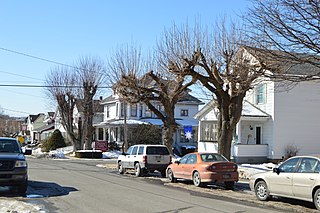
Portage is a borough with home rule status in Cambria County, Pennsylvania, United States. It is 10 miles (16 km) southeast of Ebensburg and 22 miles (35 km) southwest of Altoona. It is part of the Johnstown, Pennsylvania Metropolitan Statistical Area. The population was 2,638 at the 2010 US census.
The Westray Mine was a coal mine in Plymouth, Nova Scotia, Canada. Westray was owned and operated by Curragh Resources Incorporated, which obtained both provincial and federal government money to open the mine, and supply the local electric power utility with coal.
A mining accident is an accident that occurs during the process of mining minerals or metals. Thousands of miners die from mining accidents each year, especially from underground coal mining, although accidents also occur in hard rock mining. Coal mining is considered much more hazardous than hard rock mining due to flat-lying rock strata, generally incompetent rock, the presence of methane gas, and coal dust. Most of the deaths these days occur in developing countries, and rural parts of developed countries where safety measures are not practiced as fully.
The Blantyre mining disaster, which happened on the morning of 22 October 1877, in Blantyre, Scotland, was Scotland's worst ever mining accident. Pits No. 2 and No. 3 of William Dixon's Blantyre Colliery were the site of an explosion which killed 207 miners, the youngest being a boy of 11. It was known that firedamp was present in the pit and it is likely that this was ignited by a naked flame. The accident left 92 widows and 250 fatherless children.
Spangler, Pennsylvania was a town, since merged, and former borough located in the northwest corner of Cambria County, Pennsylvania, United States. It is nestled in the valley of the West Branch of the Susquehanna River between hills of the Appalachian Mountains of the Eastern United States. The area was first settled by Europeans in the early-to-middle 19th century. The presence of the West Branch of the Susquehanna River allowed loggers to move their harvest down river. Small farms developed and the town came into existence in 1893 when mining of extensive bituminous coal fields in the area became the dominant industry. The mining companies required skilled workers and many came from Great Britain and Eastern Europe. Railroads were built to transport the coal and the town flourished from economic activity.
New Waterford is an urban community in the Cape Breton Regional Municipality of Nova Scotia, Canada.
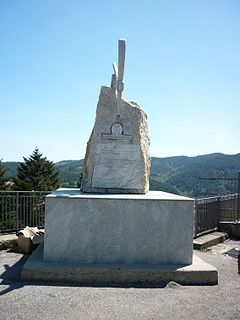
The Monongah mining disaster of Monongah, West Virginia occurred on December 6, 1907, and has been described as "the worst mining disaster in American history". 362 miners were killed. The explosion occurred in Fairmont Coal Company’s No. 6 and No. 8 mines, and was one of the contributing events leading to the creation of the United States Bureau of Mines.
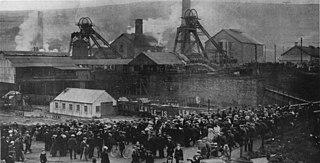
The Senghenydd colliery disaster, also known as the Senghenydd explosion, occurred at the Universal Colliery in Senghenydd, near Caerphilly, Glamorgan, Wales, on 14 October 1913. The explosion, which killed 439 miners and a rescuer, is the worst mining accident in the United Kingdom. Universal Colliery, on the South Wales Coalfield, extracted steam coal, which was much in demand. Some of the region's coal seams contained high quantities of firedamp, a highly explosive gas consisting of methane and hydrogen.
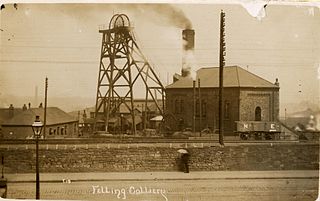
The Felling Colliery in Britain, suffered four disasters in the 19th century, in 1812, 1813, 1821 and 1847. By far the worst of the four was the 1812 disaster which claimed 91 lives on 25 May 1812. The loss of life in the 1812 disaster was one of the motivators for the development of the miners' safety lamp.

The Gresford disaster occurred on 22 September 1934 at Gresford Colliery, near Wrexham, in northeast Wales, when an explosion and underground fire killed 266 men. Gresford is one of Britain's worst coal mining disasters: a controversial inquiry into the disaster did not conclusively identify a cause, though evidence suggested that failures in safety procedures and poor mine management were contributory factors. Further public controversy was caused by the decision to permanently seal the colliery's damaged districts, meaning that only eleven of those who died were recovered.
Clifton Hall Colliery was one of two coal mines in Clifton on the Manchester Coalfield, historically in Lancashire which was incorporated into the City of Salford in Greater Manchester, England in 1974. Clifton Hall was notorious for an explosion in 1885 which killed around 178 men and boys.

The Astley Deep Pit disaster was a mining accident at the Astley Deep Pit, in Dukinfield, Cheshire, England, that took place on 14 April 1874, killing 54 men and boys. Astley Deep Pit was a coal mine started around 1845 to work the seam of coal known as the "Lancashire Black Mine". When finished, it was supposedly the deepest coal-mine in Britain and cost £100,000 to sink.
The Hurricane Creek mine disaster occurred on December 30, 1970, shortly after noon, and resulted in the deaths of 39 men. As was often pointed out in coverage of the disaster, it occurred a year to the day after the passage of the Coal Mine Safety and Health Act of 1969. Recovery was complicated by the fact that a foot of snow fell on the rural mountain roads at the time of the accident.
The Naomi Mine explosion occurred on December 1, 1907, in the Naomi Mine, approximately 2 miles (3.2 km) from Fayette City, Pennsylvania. The incident resulted in the deaths of at least 35 miners and left no survivors.
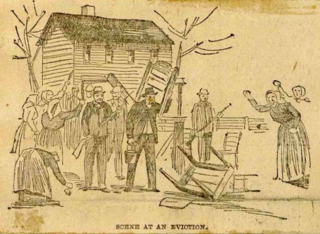
The Morewood massacre was an armed labor-union conflict in Morewood, Pennsylvania, in Westmoreland County, west of the present-day borough Mount Pleasant in 1891.
The Peckfield pit disaster was a mining accident at the Peckfield Colliery in Micklefield, West Yorkshire, England, which occurred on Thursday 30 April 1896, killing 63 men and boys out of 105 who were in the pit, plus 19 out of 23 pit ponies.

The Lundhill Colliery explosion was a coal mining accident which took place on 19 February 1857 in Wombwell, Yorkshire, UK in which 189 men and boys aged between 10 and 59 died. It is one of the biggest industrial disasters in the country's history and it was caused by a firedamp explosion. It was the first disaster to appear on the front page of the Illustrated London News.
The Sneyd Colliery Disaster was a coal mining accident on 1 January 1942 in Burslem in the English city of Stoke-on-Trent. An underground explosion occurred at 7:50 am, caused by sparks from wagons underground igniting coal dust. A total of 57 men and boys died.

The Mammoth Mine disaster or Frick Mine explosion occurred on January 27, 1891 just after 9:00 AM in the Mammoth No. 1 mine in Mount Pleasant Township, Westmoreland County, Pennsylvania. Newspapers reported that firedamp was ignited by a miner's oil lamp, resulting in the deaths of 109 men and boys. Most of the miners were not killed by the force of the explosion, but rather were suffocated by the effects of afterdamp.

Bentley Colliery was a coal mine in Bentley, near Doncaster in South Yorkshire, England, that operated between 1906 and 1993. In common with many other mines, it suffered disasters and accidents. The worst Bentley disaster was in 1931 when 45 miners were killed after a gas explosion. The site of the mine has been converted into a woodland.